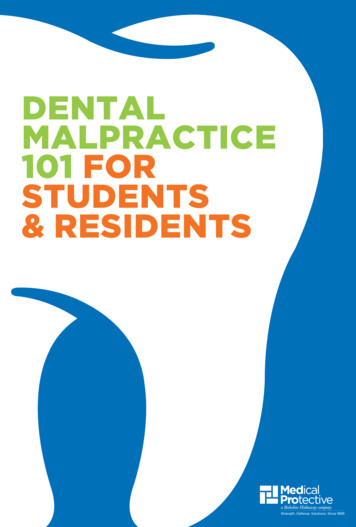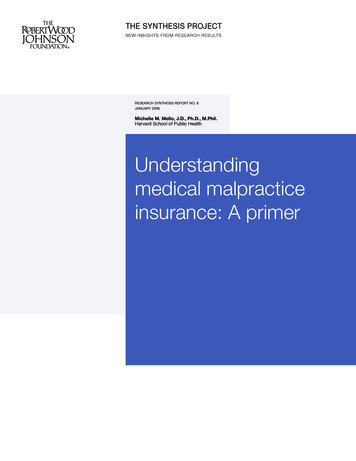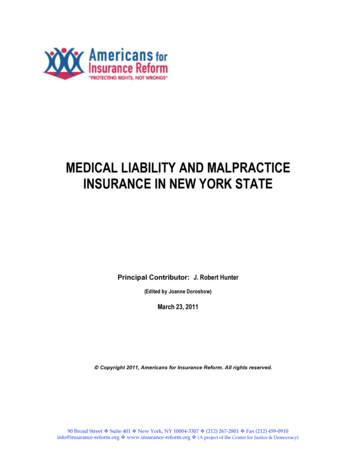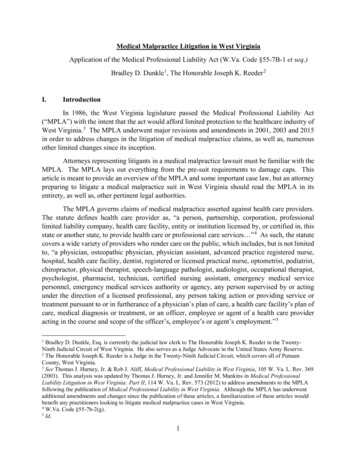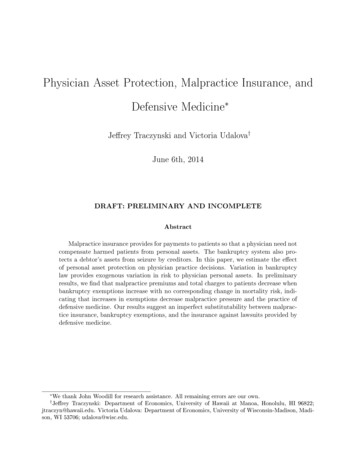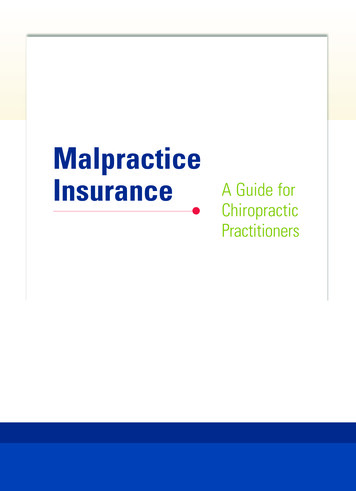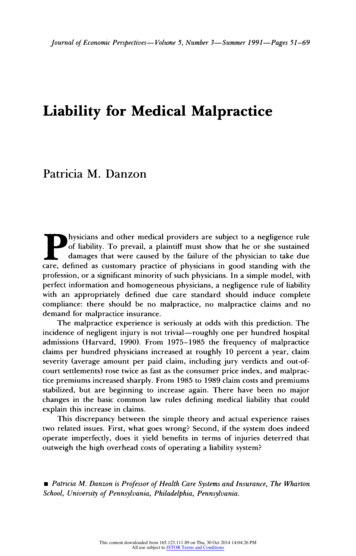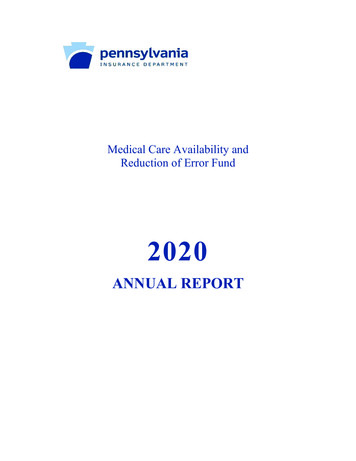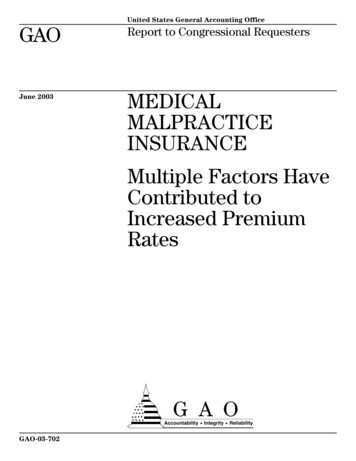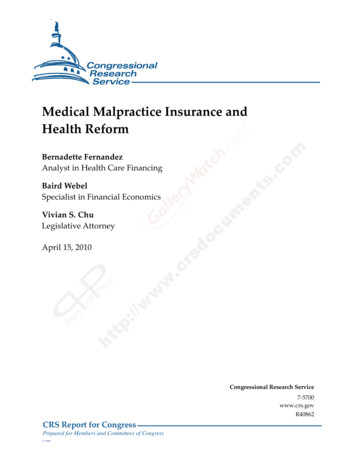
Transcription
.Medical Malpractice Insurance andHealth ReformBernadette FernandezAnalyst in Health Care FinancingBaird WebelSpecialist in Financial EconomicsVivian S. ChuLegislative AttorneyApril 15, 2010Congressional Research Service7-5700www.crs.govR40862CRS Report for CongressPrepared for Members and Committees of Congressc11173008
.Medical Malpractice Insurance and Health ReformSummaryMedical malpractice liability insurance has attracted congressional attention numerous times overthe past few decades, particularly in the midst of three “crisis” periods in the mid-1970s, the mid1980s, and the early 2000s. These crises were marked by sharp increases in physicians’ liabilityinsurance premiums, difficulties in finding any insurance in some areas as insurers withdrew fromproviding coverage, reports of physicians leaving areas or retiring following insurancedifficulties, and a variety of public policy measures at both the state and federal levels to addressthe crises. Which public policy measures have been effective in addressing the successiveinsurance crises has been a matter of debate, in part because these crises have been at theintersection of the health care, tort, and insurance systems.Currently, the medical liability insurance market is not exhibiting crisis symptoms. Over the pastfour years, losses incurred by medical malpractice insurers have dropped dramatically andpremiums paid have fallen, albeit more modestly. Problems with the affordability and availabilityof malpractice insurance persist but are less acute compared with other time periods. Even duringa non-crisis period, the current malpractice system experiences issues with equity and access. Forexample, some observers have criticized the current system’s performance with respect tocompensating patients who have been harmed by malpractice, deterring substandard medicalcare, and promoting patient safety. Yet there are differing opinions as to the extent that each ofthese particular areas has been affected by the current malpractice system.The current legislative interest in medical malpractice reform differs from the past in that it islargely driven by overall health reform, rather than an immediate crisis in medical malpracticeinsurance. In terms of direct costs, medical malpractice insurance adds relatively little to the costof health care. According to the National Association of Insurance Commissioners (NAIC),medical malpractice premiums written in 2008 totaled approximately 11.2 billion, while healthexpenditures are estimated by the Congressional Budget Office (CBO) to total 2.6 trillion.Indirect costs, particularly increased utilization of tests and procedures by physicians to protectagainst future lawsuits (“defensive medicine”), have been estimated to be much higher than directpremiums. These conclusions, however, are controversial, in part because synthesis studies haveclaimed that national estimates of defensive medicine are unreliable.The recently enacted Patient Protection and Affordable Care Act (P.L. 111-148) includes languagethat allows states to receive grants to enact and implement alternatives to tort litigation.Congressional Research Service
.Medical Malpractice Insurance and Health ReformContentsIntroduction .1Medical Malpractice and Health Reform .2Health Reform and Medical Malpractice Legislation .3Challenges in Medical Malpractice Policymaking .4Health Care System.4Tort System.5Insurance System .6Recent Experience in Medical Malpractice Insurance .7FiguresFigure 1. Nationwide Direct Losses Incurred.7Figure 2. Nationwide Loss Ratio .8ContactsAuthor Contact Information .8Congressional Research Service
.Medical Malpractice Insurance and Health ReformIntroductionMedical malpractice insurance has attracted congressional attention numerous times over the pastfew decades, particularly in the midst of three “crisis” periods in the mid-1970s, the mid-1980s,and the early 2000s. These crises were marked by sharp increases in physicians’ liabilityinsurance premiums, difficulties in finding any liability insurance in some areas as insurerswithdrew from providing coverage, reports of physicians leaving areas or retiring followinginsurance difficulties, and a variety of public policy measures at both the state and federal levelsto address the crises. In each case, the crisis receded after a few years as premium increasesmoderated and market conditions calmed. Over time, the availability of medical liabilityinsurance and premiums for such insurance has exhibited cyclical characteristics.Which public policy measures have been effective in addressing the successive insurance criseshas been a matter of debate. Sharply drawn conclusions about the causes of the crises have alsobeen strongly debated. During the most recent crisis, in the early 2000s, the debate largelyfocused on implementing federal limits on the tort system. The Congressional Budget Office(CBO) has estimated that a nationwide limit on torts for medical malpractice would lowermalpractice insurance premiums by approximately 10%.1 Other studies have found both highereffects and negligible effects from state tort reforms.2According to the latest summary information published by the Medical Liability Monitor,premiums for 2009 for malpractice insurance “have eased nationwide.”3 Figures show that for2009, 58% of premiums had no change and 36% of premiums fell. 4 Although the current medicalliability insurance market is not exhibiting crisis symptoms, problems still exist with affordabilityof malpractice insurance for certain specialties and in particular geographic regions; suchproblems, however, are not as acute as compared with other crisis periods. Thus, by extension,physicians and physician groups (primarily the American Medical Association) are notresponding to current market conditions in the same manner as during crisis periods. Forexample, during a crisis period, physicians and physicians groups have engaged in more publicdisplays of dissatisfaction such as participating in “strikes.” However, even during a non-crisisperiod, the current malpractice system experiences issues with equity and access. For example,some observers have criticized the current system’s performance with respect to compensatingpatients who have been harmed by malpractice, 5 deterring substandard medical care,6 andpromoting patient safety.71Congressional Budget Office (CBO), “CBO’s Analysis of the Effects of Proposals to Limit Costs Related to MedicalMalpractice (“Tort Reform”), Letter to the Honorable Orrin G. Hatch,” Oct. 9, 2009, available at http://www.cbo.gov/doc.cfm?index 10641.2See, e.g., Kenneth E. Thorpe, “The Medical Malpractice ‘Crisis’: Recent Trends and the Impact of State TortReforms,” Health Affairs, Web Exclusive, Jan. 21, 2004, and General Accounting Office, “Medical Malpractice: SixState Case Studies Show Claims and Insurance Costs Still Rise Despite Reforms,” GAO/HRD-87-21, December 1986.3Amy Lynn Sorrel, “Liability premiums stay stable, but insurers warn this might not last,” American Medical News,Nov. 23, 2009, available at 23.htm. See also Chad Karls,“Medical Liability Monitor,” Vol. 33, No. 10, October 2008, p. 1.4Sorrell, supra note 3.5E. Thomas, et al., “Incidence and Types of Adverse Events and Negligent Care in Utah and Colorado,” Medical Care,Vol. 38, No. 3, (Mar. 2000); T. Brennan, et al., “Incidence of Adverse Events and Negligence in Hospitalized Patients,”New England Journal of Medicine, Vol. 324, No. 6, (Feb. 7, 1991).6Michelle M. Mello and Troyen A. Brennan, “Deterrence of Medical Errors: Theory and Evidence for Malpractice(continued.)Congressional Research Service1
.Medical Malpractice Insurance and Health ReformMedical Malpractice and Health ReformThe current legislative interest in medical malpractice reform differs from the past in that it islargely driven by overall health reform, rather than an immediate crisis in malpractice liabilityinsurance. As such, the focus of reforming medical malpractice is likely to be broadened. Insteadof addressing what can be done to stabilize premiums for malpractice insurance, Congress maydecide to focus on how changes to the medical malpractice system might affect overall healthreform.In terms of direct costs, medical malpractice insurance adds relatively little to the cost of healthcare. According to the National Association of Insurance Commissioners (NAIC), medicalmalpractice premiums written in 2008 totaled approximately 11.2 billion, 8 while healthexpenditures estimated by CBO total 2.6 trillion.9 Indirect costs, particularly increasedutilization of tests and procedures by physicians to protect against future lawsuits (“defensivemedicine”), have been estimated to be much higher than direct premiums. These conclusions,however, are controversial, in part because synthesis studies have claimed that national estimatesof defensive medicine are unreliable.10CBO conducted its own analysis, as well as synthesized and analyzed previous studies on therelationship between medical malpractice and health care costs.11 The most recent CBO analysisestimated that federal tort reforms would reduce national health care spending by about 0.5% in2009 (equivalent to approximately 11 billion). 12 This estimate is the cumulative impact of tortreform on both lowering medical malpractice insurance premiums and reducing use of health careservices, and takes into account the fact that because some states have implemented tort reforms,a significant proportion of potential cost savings already has been realized. Other earlier studieshave estimated the reduction of health care spending attributable to state tort reforms. Thesestudies compared pre- and post-reform spending within each state that implemented such reforms,and found varying impact (e.g., a set of studies found 4-9% reduction in hospital spending forMedicare patients with heart disease; another study found that state tort reforms reduced personalhealth care expenditures by 3-4%).13(.continued)Reform,” 80 Tex. L. Rev. 1595 (2002).7L. Sato, et al., “Legal Liability and Protection of Patient Safety Data,” Harvard Risk Management Foundation, 2005.8NAIC, “Countrywide Summary of Medical Malpractice Insurance, Calendar Years 1991-2008,” September 1, 2009.9Douglas Elmendorf, “Expanding Health Insurance Coverage and Controlling Costs for Health Care,” testimonyprovided to the Senate Budget Committee, February 10, 2009.10See, e.g., Michelle Mello, “Understanding medical malpractice insurance: A primer,” Robert Wood JohnsonFoundation, Research Synthesis Report No. 8, Jan. 2006, and Office of Technology Assessment, “Defensive Medicineand Medical Malpractice,” 1994.11See CBO, “Budget Options, Volume 1: Health Care,” December 2008.12CBO, “CBO’s Analysis of the Effects of Proposals to Limit Costs Related to Medical Malpractice (“Tort Reform”),Letter to the Honorable Orrin G. Hatch,” Oct. 9, 2009, available at http://www.cbo.gov/doc.cfm?index 10641.13See P. Danzon, “Liability for Medical Malpractice,” Handbook of Health Economics, Culyer and Newhouse, eds.,2000; D. Kessler and M. McClellan: “How Liability Law Affects Medical Productivity,” Working Paper No. 7533,National Bureau of Economic Research, Feb. 2000), and “Do Doctors Practice Defensive Medicine?,” QuarterlyJournal of Economics, Vol. 111, No. 2, May 1996; and F. Hellinger and W. Encinosa, “The Impact of State LawsLimiting Malpractice Damage Awards on Health Care Expenditures,” American Journal of Public Health, Aug. 2006.Congressional Research Service2
.Medical Malpractice Insurance and Health ReformCBO also estimated the effect of malpractice tort reform on the federal budget. In its latestanalysis, CBO estimated that such reforms would reduce spending under Medicare, Medicaid, theChildren’s Health Insurance Program, and the Federal Employees Health Benefits Program byapproximately 41 billion from 2010 to 2019. In addition, Congress’s Joint Committee onTaxation (JCT) estimated that such reforms would lead to an increase in federal revenues by 13billion over the same 10-year period.14 By combining the impact of tort reform on mandatoryhealth spending and tax revenues, CBO estimated that tort reforms could reduce the federalbudget deficit by approximately 54 billion over 10 years.15Health Reform and Medical Malpractice LegislationThe Patient Protection and Affordable Care Act (PPACA) (P.L. 111-148) was signed into law onMarch 23, 2010. The language of PPACA was that of H.R. 3590, which was passed by the Senateon December 24, 2009. It includes two provisions related to medical malpractice liability reform.As will be discussed below, it is the states that regulate or that have implemented tort reform formedical malpractice law suits. PPACA is the first law enacted where Congress not only expressesthat it should establish state demonstration programs to evaluate alternatives to tort litigation, butin fact establishes such an initiative, which will be in effect for five years.Section 6801 expresses the Sense of the Senate that (1) health care reform presents an opportunityto address issues related to medical malpractice and medical liability insurance; (2) states areencouraged to develop and test litigation alternatives while preserving an individual’s right toseek redress in court; and (3) Congress should consider establishing a state demonstrationprogram to evaluate alternatives to the existing civil litigation system with respect to medicalmalpractice claims.Section 10607 creates a new Public Health Services Act section 933V-4, which appropriates 50million for a five-year period beginning in FY2011 for the Secretary to award demonstrationgrants to states for the development, implementation, and evaluation of alternatives to current tortlitigation for resolving disputes over injuries allegedly caused by health care providers ororganizations. These grants will exist for no more than five years. States that receive a grant arerequired to develop an alternative that (1) allows for the resolution of disputes caused by healthcare providers or organizations, and (2) promotes a reduction of health care errors by encouragingthe collection and analysis of patient safety data related to the resolved disputes.Prior to receiving a grant, a state will have to demonstrate that its alternative (1) increases theavailability of prompt and fair resolutions of disputes, (2) encourages the efficient resolution ofdisputes, (3) encourages the disclosure of health care errors, (4) enhances patient safety byreducing medical errors and adverse events, (5) improves access to liability, (6) informs thepatient about the differences between the alternative and tort litigation, (7) allows the patient toopt out of the alternative at any time, (8) does not conflict with state law regarding tort litigation,and (9) does not abridge a patient’s ability to file a medical malpractice claim.14Much of health care consumed in the private sector is provided through employer-sponsored health benefits that arenot taxed as income for the employee. The JCT assumed that implementation of tort reforms would lead to lower healthcare costs, which in turn, would lead to higher wages, which are taxable. Thus, higher taxable income would result ingreater revenue.15CBO, “CBO’s Analysis of the Effects of Proposals to Limit Costs Related to Medical Malpractice (‘Tort Reform’),”Letter to the Honorable Orrin G. Hatch, Oct. 9, 2009, available at http://www.cbo.gov/doc.cfm?index 10641.Congressional Research Service3
.Medical Malpractice Insurance and Health ReformEach state will have to identify the sources from and methods by which compensation will bepaid, which can include public and private funding sources. In addition, each state will have toestablish a scope of jurisdiction to whom the alternative will apply so that it is sufficient toevaluate the effects of the alternative. The Secretary will provide to the states that are applying forthe grants technical assistance, including guidance on common definitions, non-economicdamages, avoidable injuries, and disclosure to patients of health care errors and adverse events.When reviewing states’ grant applications, the Secretary will consult with a newly establishedreview panel that will be composed of relevant experts appointed by the Comptroller General.There are various reporting requirements that must be completed. First, states that receive a grantmust submit a report to the Secretary covering the impact of the activities funded on patient safetyand on the availability and price of medical liability insurance. Second, the Secretary must submitan annual compendium to Congress that examines any differences that may result in the areas ofquality of care, number and nature of medical errors, medical resources used, length of time fordispute resolution, and the availability and price of liability insurance. Third, the Secretary, inconsultation with the review panel, must contract with a research organization to conduct anoverall evaluation of the effectiveness of grants awarded. This evaluation must be submitted toCongress no later than 18 months following the date of implementation of the first fundedprogram. Fourth, the Medicare Payment Advisory Commission (MedPAC) and the Medicaid andCHIP Payment and Access Commission (MACPAC) must each conduct an independent review ofthe impact of state-implemented alternatives on their programs and beneficiaries. These reportsmust be submitted no later than December 31, 2016. These reports may provide new andinformative data about the impact and effect of tort reform.The section does not limit any prior, current, or future efforts of any state to establish anyalternative to tort litigation.Challenges in Medical Malpractice PolicymakingAddressing problems in the medical malpractice insurance markets can be challenging, as thesemarkets react to three different systems, each of which is complex in its own right: health care,tort, and insurance.Health Care SystemMedical errors can lead to injury, and injury is the medical basis on which a malpractice claim ismade. Reducing errors through improved medical practices and effectuating penalties againstpoorly performing physicians may benefit the overall performance of the medical malpracticeinsurance system.States have the primary authority to define the process for granting and renewing a medicallicense, and regulating the medical practice. Currently, there is a lack of uniformity across statesregarding both medical licensure and the medical practice. Moreover, states face financialchallenges and many lack clinical expertise to fully implement patient safety strategies. Forexample, current state initiatives vary regarding the existence, scope, and robustness of datacollection efforts to track and analyze medical errors and possible instances of malpractice.Federal input may be implemented through a variety of approaches, both voluntary (e.g., supportfor research on evidence-based medicine, and toolkits to evaluate the adoption of patient safetyCongressional Research Service4
.Medical Malpractice Insurance and Health Reformefforts) and mandatory (e.g., “conditions of participation” standards for institutional providersunder the Medicare program).While reducing medical errors may be a worthy goal in its own right, it is unclear to what degreemedical malpractice insurance will be affected if only patient safety concerns are addressed.Multiple studies have found that the majority of malpractice claims filed involve medical injuriesnot caused by negligence.16 Moreover, only a small proportion of patients whose injuries arecaused by negligent medical care actually end up filing a malpractice claim. 17 These findingsspeak to the complexity of the existing medical liability system, and difficulty in designingeffective policies without consideration of the interrelated systems.Some observers suggest that the current malpractice system encourages the practice of “defensivemedicine,” that is, the fear of liability and the potential negative outcomes associated withmalpractice claims lead physicians to administer additional health care treatments or avoid highrisk services primarily to reduce their liability risk. The implication is that defensive medicineresults in either an increase in overall consumption of and spending on health care services thatmay not be medically necessary, or a decrease in access to certain services or for certain patients.Multiple studies have found some evidence of defensive medicine, but even physician and otherprovider groups acknowledge that it is a difficult concept to measure.18 Moreover, some evidencesuggests that factors other than defensive medicine, such as physician payment systems (e.g., feefor-service vs. capitation) and financial incentives, may explain the alleged over-provision ofhealth services.19Tort SystemThe tort system acts as a mechanism through which a person suffering injury due to medicalerrors is monetarily compensated when he or she establishes that a physician providedsubstandard health care. Some argue that the tort system is an efficient way to both compensatethose who suffer from an injury and to deter the errors that created the injury, and that the tortsystem is the primary way that the present system deals with such issues. However, there arethose who argue that, in the case of medical malpractice, the current system does neitherparticularly well.20 Some observers have suggested that the medical malpractice tort system isarbitrary in its outcome. 21 As noted above, many valid claims are never filed and many filed16See, e.g., David Studdert, et al., “Negligent Care and Malpractice Claiming Behavior in Utah and Colorado,”Medical Care, (Mar. 2000); Paul Weiler, et al., A Measure of Malpractice (1993); T. Brennan, et al., “Incidence ofAdverse Events and Negligence in Hospitalized Patients: Results of the Harvard Medical Practice Study I,” NewEngland Journal of Medicine, Vol. 324, No. 6, (Feb. 7, 1991).17David Studdert, et al., “Negligent Care and Malpractice Claiming Behavior in Utah and Colorado,” Medical Care,(Mar. 2000).18General Accounting Office, “Medical Malpractice: Implications of Rising Premiums on Access to Health Care,”GAO-03-836, August 2003.19Ibid.20See analysis presented by M. Mello and D. Studdert, “The Medical Malpractice System: Structure and Performance,”Medical Malpractice and the U.S. Health Care System, W. Sage and R. Kersh, eds., Cambridge University Press, 2006.21“Addressing the New Health Care Crisis: Reforming the Medical Litigation System to Improve the Quality of HealthCare,” Office of the Assistant Secretary for Planning and Evaluation, U.S. Department of Health and Human Services,Mar. 3, 2003.Congressional Research Service5
.Medical Malpractice Insurance and Health Reformclaims are not the result of negligence. Jury verdicts can vary significantly from case to case, withsubstantial variation also occurring among states and among counties within states.Some medical malpractice reforms also contribute to this variation. For example, in a case wherethere is a permanently disabled mid-career high wage earner compared to a non-wage earner withthe same injury, a jury awarding non-economic damages 22 where there is no cap may tend to givethe working person higher non-economic damages. However, where there is a cap on noneconomic damages, this may mean that the high wage earner is prevented from beingcompensated as highly for his non-economic damages. Data on tort outcomes for medicalmalpractice are difficult to gather as there is no central or authoritative tracking source from thecounties where many trials occur, nor is there such a source from the states or the federalgovernment.23Insurance SystemLiability insurance insulates physicians from the direct cost of medical malpractice. It acts as abuffer between the actual award for malpractice determined under the tort system and thephysician who may have committed malpractice. The vast majority of physicians have liabilityinsurance, although there is anecdotal evidence about some physicians practicing medicinewithout malpractice insurance. By its nature, insurance spreads the costs across a wide base ofphysicians in a particular specialty or geographic area, so that the actions of a relatively smallnumber of physicians can have a wider impact.Specific aspects of the insurance system can arguably catalyze or magnify crises. Medicalmalpractice claims tend to play out over an extended period of time, due both to the lag inrecognizing that a claim might exist and to deliberations in the court system. Insurance is basedon estimating future claims and estimating the investment returns on premium payments from thetime premiums are paid until the time claims are paid. The longer time period associated withliability insurance losses increases uncertainty in these estimations, with such uncertaintypossibly leading to increased volatility in premiums.Medical malpractice liability insurance is regulated by the individual states under the federalMcCarran-Ferguson Act, which also provides a limited exemption from federal antitrust laws.This has resulted in variations in the structure of the markets as well as in the data generated.NAIC aggregates some insurance data; however, much potentially useful data is either notcollected or not available. For example, data encompassing all the medical malpractice claimsclosed by insurers can give a broad picture of the situation in medical malpractice insurance;however, only a handful of states either collect such data or make it available to researchers.22Non-economic damages typically compensate for intangibles such as pain and suffering and capacity to enjoy life, asopposed to economic damages which compensate for more tangible elements such as medical expenses and loss ofearnings.23However, a private company, Jury Verdict Research, is a commonly cited source for information on awards frommedical malpractice cases as they collect and analyze data.Congressional Research Service6
.Medical Malpractice Insurance and Health ReformRecent Experience in Medical Malpractice InsuranceThe cyclical experience of medical malpractice insurers is reflected in aggregate data about theindustry compiled and analyzed by the NAIC (see Figure 1). From 1992 to 1998, direct incurredlosses24 were relatively stable, varying from a low of 3.18 billion in 1994 to a high of 4.46billion in 1998. However, from 1998 to 2003, losses grew steadily year after year, to a high of 8.46 billion in that last year, coinciding with the last crisis period. Since 2003, losses have fallenevery year. In 2008, losses totaled 4.09 billion, the lowest amount in a decade. (The loss data isin nominal dollar amounts.)25Figure 1. Nationwide Direct Losses IncurredBillions ( Calendar YearSource: National Association of Insurance Commissioners.The trend in malpractice insurance premiums has roughly followed losses as those amounts haveincreased. However, such premiums have not fallen nearly as much as losses in recent years. Theloss ratio, which compares losses to premiums, reflects this uneven trend (see Figure 2). A highratio generally implies lower profits for insurers on the insurance portion of their operations. Theloss ratio for the industry rose steadily from 78.41% in 1997 to 126.83% in 2001, tracking closelywith the losses trend. Since 2001, the loss ratio has rapidly decreased. In 2008, the loss ratio of54.62% was the lowest one in nearly two decades, meaning that the industry experienced itshighest profit margin on direct premiums earned in the calendar years analyzed.24Incurred losses are payments for claims during a certain time period, in this case during a calendar year. Incurredlosses for any given year include payments for claims submitted prior to that year, and account for outstanding claimsat the end of the time period. The NAIC loss data is in nominal dollar amounts.25The distinction between nominal vs. real dollars is significant when considered over the longer time period. Forexample, while the 2008 loss of 4.09 billion does not seem much more than the 1992 loss of 4.04 billion, becausethese amounts do not reflect the effects of inflation and the time value of money, the 2008 losses are actually muchlower than those in 1992.Congressional Research Service7
.Medical Malpractice Insurance and Health 99199199199254.621Loss Ratio (%)Figure 2. Nationwide Loss RatioCalendar YearSource: National Association of Insurance Commissioners.Notes: Loss Ratio (Direct Losses Direct Defense and Cost Containment Expenses Incurred)/DirectPremiums Earned.Insurers, who are strictly regulate
malpractice insurance premiums by approximately 10%.1 Other studies have found both higher effects and negligible effects from state tort reforms.2 According to the latest summary information published by the Medical Liability Monitor, premiums for 2009 for malpractice insurance "have eased nationwide."3 Figures show that for
